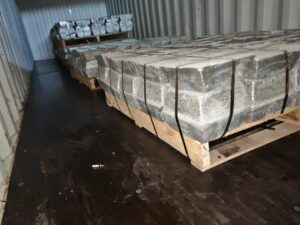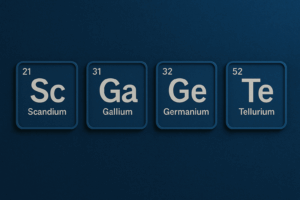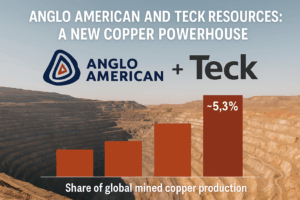Introduction
Core Consultants has had a flurry of inquiries from semiconductor manufacturers requiring urgent market intelligence to help diversify their supply chains with respect to Tungsten powder.
In early 2025, China sent shockwaves through global technology and manufacturing industries by tightening export restrictions on critical minerals, including tungsten. Though rarely in the headlines compared to lithium or cobalt, tungsten is a strategic material essential to advanced manufacturing, defense, and especially the semiconductor industry. Its derivative, tungsten hexafluoride (WF₆), is an indispensable gas used in the chemical vapor deposition (CVD) process to create ultra-thin conductive layers inside chips. With China controlling over 80 percent of global tungsten supply, the new restrictions have triggered widespread anxiety and forced industry leaders to rethink sourcing strategies.
This article examines the implications of China’s tungsten export restrictions, explores the role of WF₆ in semiconductor manufacturing, and outlines potential solutions for companies and governments seeking to secure this critical input.
China’s Tungsten Grip
Tungsten, known for its exceptional hardness and highest melting point among metals, has long been a cornerstone of defense applications, aerospace, tooling, and electronics. The semiconductor industry, however, depends on tungsten in gaseous form WF₆ for filling transistor contacts and vias with reliable, high-performance material.
China dominates this landscape. According to industry data, more than four-fifths of tungsten mining and refining capacity is located within its borders. On February 4, 2025, Beijing announced that tungsten and several other metals would now require export licenses. While not a total ban, export permits have been slow to materialize, effectively creating a chokepoint in the global supply chain. Prices for tungsten intermediates such as ammonium paratungstate (APT) have already surged, in some cases by 30–70 percent.
For semiconductor fabs, which typically run with lean inventories and long lead times for specialty gases, this creates both cost inflation and the risk of production halts.
Tungsten Hexafluoride: A Small Volume, Huge Impact Material
Tungsten hexafluoride may only account for a fraction of total tungsten demand by weight, but its strategic importance is outsized. In advanced logic and memory chips, WF₆ is used to deposit conductive tungsten films that connect billions of transistors. Without it, critical steps in chip fabrication grind to a halt.
Unlike bulk tungsten powders or alloys, WF₆ has a limited number of production facilities worldwide, many of which source their raw tungsten feedstock directly or indirectly from China. This makes the gas especially vulnerable to geopolitical shocks. The shortage risk is compounded by the difficulty of substituting WF₆: while alternatives such as molybdenum or cobalt-chrome alloys exist in some engineering applications, in semiconductor deposition processes WF₆ remains irreplaceable due to its unique chemical properties and established equipment compatibility.
The Global Fallout
China’s move has reverberated far beyond its borders:
- Semiconductor Manufacturing Disruption
Leading chipmakers in Taiwan, South Korea, Japan, Europe, and the United States face immediate challenges in securing adequate WF₆ supplies. Even minor disruptions in availability could cause cascading delays in chip output, affecting industries from consumer electronics to electric vehicles. - Price Volatility
Benchmark tungsten prices have spiked sharply since the export controls were announced. For manufacturers operating on tight margins, this threatens profitability. Long-term contracts are being renegotiated, and uncertainty is creating stockpiling behavior across industries. - Strategic Vulnerability
Governments in the West are now acutely aware that over-reliance on Chinese supply chains for critical minerals leaves them strategically exposed. This mirrors earlier shocks seen in rare earths and graphite markets.
How the World Is Responding
1. Diversifying Supply
Nations and companies are urgently working to develop tungsten mines outside China. Key projects include:
- Sangdong Mine (South Korea): Expected to supply up to 30 percent of non-Chinese tungsten demand, with long-term contracts already signed with U.S. buyers.
- Mactung (Canada): One of the largest undeveloped tungsten deposits, now receiving U.S. Department of Defense backing.
- Panasqueira (Portugal): Operated by Almonty Industries, extending Europe’s independent supply.
- Vietnam’s Nui Phao: A major existing mine where Western governments are working to prevent Chinese acquisition.
These projects represent progress, but most will take years to reach full-scale production.
2. Recycling and Circular Economy
Recycling tungsten from industrial scrap and end-of-life products is gaining traction. Advanced recovery techniques can reclaim high-purity tungsten suitable for WF₆ production, reducing dependency on mined supply. Some semiconductor fabs are exploring closed-loop recycling systems to capture tungsten waste during processing.
3. Material Substitution and R&D
Where feasible, industries are experimenting with material substitutes. While WF₆ remains unmatched in chip fabrication, in other high-strength applications materials like molybdenum, cobalt alloys, and advanced steels can replace tungsten. Governments are also funding R&D into alternative deposition chemistries, though widespread adoption remains years away.
4. Strategic Alliances
Countries are forging new partnerships to secure critical mineral supply. The U.S. and South Korea’s agreements on Sangdong, European investment in Portuguese tungsten, and multilateral efforts to secure Vietnamese output illustrate a growing geopolitical coalition to counter China’s dominance.
What Should Companies Do?
For semiconductor manufacturers and industries dependent on tungsten, several strategies emerge:
- Secure Long-Term Contracts: Lock in supply with emerging producers like Sangdong or Mactung before demand exceeds capacity.
- Invest in Recycling: Partner with recyclers or build internal recovery capabilities to create closed-loop tungsten supply.
- Collaborate on R&D: Support research into alternative materials and deposition technologies to reduce WF₆ reliance.
- Diversify Geographically: Avoid over-concentration in any single supply region, even outside China.
- Engage Governments: Work with policymakers to align on critical mineral strategies, subsidies, and trade agreements.
Policy Implications
For governments, tungsten is no longer a niche concern—it is a national security issue. Policies to consider include:
- Strategic Stockpiling: Maintain emergency reserves of tungsten intermediates and WF₆.
- Support for Mining Projects: Offer funding, permitting fast-tracks, and public-private partnerships to accelerate new sources.
- Allied Supply Chains: Build trusted critical mineral networks with like-minded countries.
- Recycling Incentives: Encourage industry to adopt circular supply chains through subsidies or tax credits.
Conclusion
China’s restrictions on tungsten exports highlight a recurring theme of the 21st century: the geopolitics of materials is inseparable from the future of technology. Tungsten hexafluoride, though obscure to the public, is a lifeblood chemical for the semiconductor industry. Its scarcity underlines how even small-volume specialty materials can exert outsized influence on global innovation.
The crisis has forced companies and governments to take urgent action: diversifying supply chains, investing in recycling, and pursuing strategic alliances. Yet these solutions will take time to bear fruit. Until then, the semiconductor industry will remain vulnerable to price volatility and supply disruptions.
In the longer term, the lesson is clear. Building resilient, diversified, and sustainable supply chains for critical minerals like tungsten is not optional-it is a prerequisite for technological sovereignty and economic security in an era of intensifying global competition.





